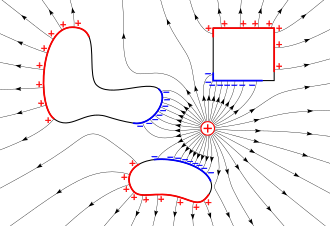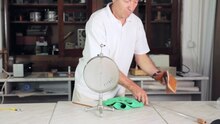Indukcja elektrostatyczna


Indukcja elektrostatyczna (zwana też influencją elektrostatyczną) – zjawisko fizyczne, sposób elektryzowania ciała w wyniku zbliżenia do niego naelektryzowanego ciała.
W przewodnikach
Zbliżenie ciała naelektryzowanego odpowiada wprowadzeniu ciała do pola elektrycznego. W przewodniku wprowadzonym do pola elektrycznego ładunki swobodne przesuwają się tak, by wewnątrz przewodnika nie było pola elektrycznego. W wyniku czego przewodnik pozostaje elektrycznie obojętny (tak jak przed zbliżeniem) jako całość, ale jego części uzyskują ładunek elektryczny zwany ładunkiem indukowanym.
Przesunięte ładunki zmieniają pole elektryczne nie tylko w przewodniku ale także w otaczającej przestrzeni. Po odsunięciu ładunku indukującego (bez rozdzielania) układ ładunków w przewodniku powraca do poprzedniego stanu.
Jeżeli części przewodnika zostaną rozdzielone (rozłączone elektrycznie) na elementy o różnym stanie naelektryzowania, to powstaną ciała trwale naelektryzowane.
W dielektrykach
W dielektrykach pole elektryczne powoduje tylko niewielkie przesunięcie ładunków wywołując polaryzację dielektryka[1]. Zazwyczaj polaryzacja ustępuje po wysunięciu dielektryka z pola elektrycznego, ale w ferroelektrykach pozostaje niewielka jej część zwana polaryzacją resztkową. Istnieją substancje zachowujące trwale stan naelektryzowania nazywane są one piroelektrykami.
Występowanie i zastosowanie
Zjawisko indukcji elektrostatycznej jest odpowiedzialne za większość przypadków elektryzowania się ciał, np. taśmociągów, samochodu jadącego drogą, osoby chodzącej po izolującej podłodze.
Zjawisko to jest podstawą działania maszyny elektrostatycznej i generatora Van de Graaffa, urządzeń do uzyskiwania ciał naelektryzowanych.
Indukcja elektrostatyczna powoduje przyciąganie naelektryzowanego przez indukcję ciała, przez ciało które wywołało to naelektryzowanie. Siła ta jest wynikiem niejednorodności pola elektrycznego. Na ciało naelektryzowane działa siła w kierunku większego natężenia pola elektrycznego. Przykładem może być przyciąganie niewielkich skrawków papieru przez naelektryzowaną pałeczkę ebonitową.
Zobacz też
Przypisy
- ↑ Indukcja elektrostatyczna, [w:] Encyklopedia PWN [online] [dostęp 2021-07-23].
Media użyte na tej stronie
Diagram of electric charges induced in conductive objects (shapes) by the electrostatic field (lines with arrows) of a nearby charge (+), due to electrostatic induction.
Autor: Andrejdam, Licencja: CC BY-SA 4.0
Using an electroscope to show electrostatic induction. When the electroscope is touched with a negatively charged ebonitе rod, the electroscope stays permanently charged. When the rod is brought near the head of the electroscope (NO CONTACT), the electroscope again is charged. But when the rod is removed, the electroscope is neutral again. This phenomenon is called electrostatic induction. In this case the object is charged only while there is a presence of the charged rod. Negative electrons are repelled by the negative rod and are concentrated in the leaves of the electroscope. Thus, they are negative, while the head of the electroscope is positive. It is similar when glass rod is used. Since it is positively charged, the electrons are attracted to the head and it acts like negative, while the leaves are positively charged. When the rod is near the electroscope and if the experimenter touches the head of the electroscope, the negative electrons are repelled into the experimenter's body. When the experimenter removes the finger, the electroscope remains positive. Prepared, performed and explained by Prof. Oliver Zajkov at the Physics Institute at the Ss. Cyril and Methodius University of Skopje, Macedonia.
Drawing of a gold leaf electroscope, an antique scientific instrument invented in 1787 by British clergyman Abraham Bennett that detects electric charge. It consists of a pair of delicate gold leaves hanging parallel to each other from a brass post, protected by a glass jar. The brass post projects from the mouth of the jar and ends in an electrode to which charged objects can be applied. When a charge is applied to the post, the leaves, carrying the same charge, repel each other, and diverge into a "V" shape. This example shows electrostatic induction of charge in the instrument by holding a charged dielectric rod near it. The positive charge on the rod causes the mobile charges in the brass post to separate, with negative charges being attracted into the top electrode, while positive charges are repelled into the leaves, causing them to separate. Alterations to image: Added colored plusses and minuses showing areas of charge.



